


|
Welcome to bobklips.com, the website of Bob Klips, a plant enthusiast living in Columbus, Ohio.
May 20, 2008
Old State Route 315
Rte
315 in Delaware OH is a pleasantly wooded road that runs along the
Olentangy River and has some upper-scale homes along it. At a lane
enterning one of these classy neighborhoods, there is a mulched garden bed
where for the past week or so there has been a constant crop of this
big mushroom.
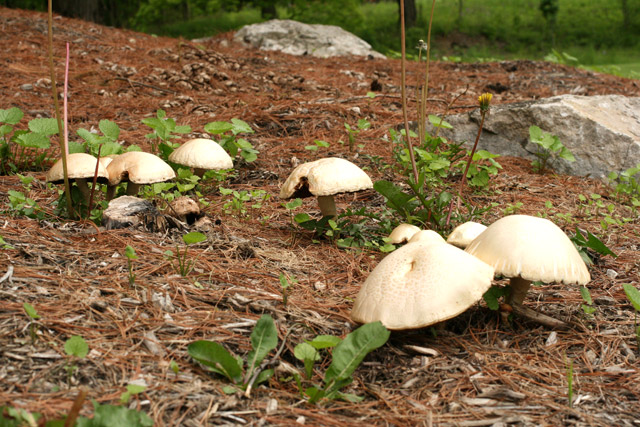 Mulched bed along Rte 315, Delaware, OH, May 20, 2008.
Mulched bed along Rte 315, Delaware, OH, May 20, 2008.
Fungi
like this one are generally called "agarics," a general term for
stalked, gilled mushrooms. Unless it's a very distinctive one
distinguishable by form alone, identification starts with a
determination of spore color. This is facilitated by placing a severed
fresh cap on a piece of paper and waiting a day. This one has brown
spores. Based on the habitat, it seems to be Agrocybe dura.
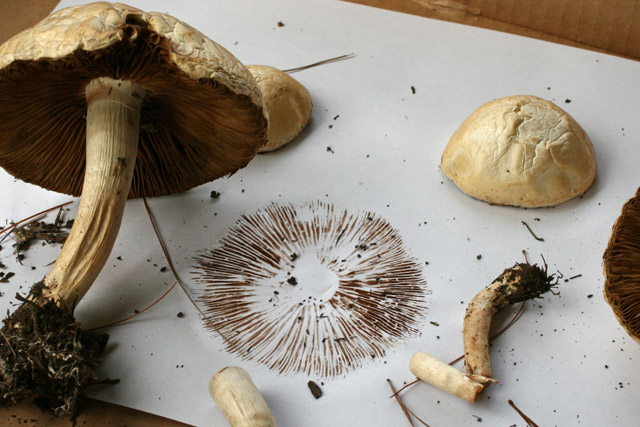 Putative Agrocybe dura spore print showing brown spores.
Putative Agrocybe dura spore print showing brown spores.
May 20, 2008
Terradise Nature Preserve
Terradise is a 12-acre nature preserve located
alongside the Whetstone River southwest of Caledonia, Marion County, OH that was
recently donated to the Marion County Parks District by longtime Marion County resident Trella Romine. She is a versatile and skilled naturalist, keen student and promoter of local history, and devoted conservationist.
This morning my friend Rich and I went on a hike there with our friend
Trella.
Rich and Trella enjoying hike at Terradise Nature Preserve, Marion County, OH May 20, 2008.
The botanical highlight of the day was the profuse flowering display of
the native prairie and woodland wildflower wild hyacinth (Cammasia scilloides),
a member of the lily family (Liliaceae). Like most monocots, it has
linear leaves with parallel veins and the flower parts are in 3's (or
multiples thereof): 3 sepals, 3 petals, 6 stamens, and a pistil
consisting of 3 fused carpels. Most members of this family (trillium is
a noted exception) have petals and sepals that look alike --colorful,
petal-like --and are thus called "tepals."
Terradise Nature Prserve, May 20, 2008.
Wild hyacinth was being visited by
honeybees. One another note, a "mystery plant" that occurs here and
elsewhere in central OH would be easy to ID if we were to have
ever noticed it at a later stage (in flower). It bears arrow-shaped
leaves with a distinctively winged leafstalk. The mystery plant
seems like a Prenanthes (family Asteraceae) of some sort. Hmmm.
Left: wild hyacinth. Right: unknown plant with distinctive leaves. Terradise Nature Preserve, May 20, 2008.
Terradise is home to some impressive groves of pawpaw (Asimina triloba,
family Anonaceae) that were in flower. Trella mentioned that they
do produce fruit, and they seem to get eaten prety quickly by wildlife.
We speculated it may be opossums that take them.
Pawpaw at Terradise, May 20, 2008.
Violets are still in bloom. An especially abundant species here is the creamy white violet, Viola striata,
family Violaceae. The breeding system of violets is interesting in that
they produce two types of flowers. Early in the season there are the
showy ones we are familair with, which attract pollinators and produce
offspring mainly through cross-pollination. Later in the season, when
it seems like the violets are done flowering, they produce
inconspicuous ones that self-pollinate in the bud.
Creamy white violet at Terradise, May 20, 2008.
There is a lot of variation within many plant species. When we saw this green-flowered sessile trillium (Trillium sessile,
family Liliaceae), we thought that maybe we were on to something
special, perhaps a species we had never encountered before, as normally
the flowers of sessile trillium (also called "toadshade") are a deep
maroon. But E. Lucy Braun in "Monocots of Ohio" mentioned that
sometimes the flowers are this color. Oh well, not a new species but very interesting anyhow.
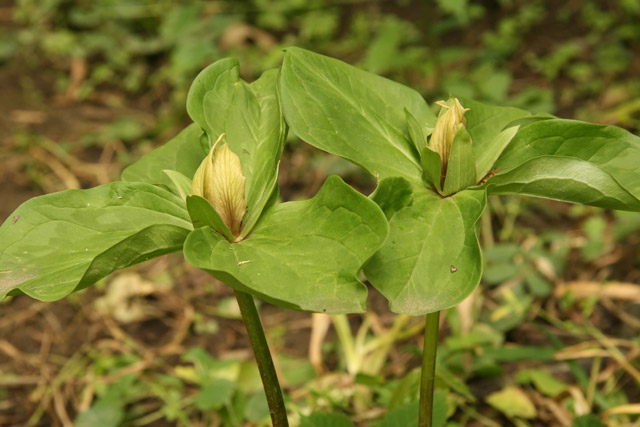
Green flowered form of sessile trillium at Terradise, May 20, 2008.
An interesting aspect of plants is the mechanisms that flowers sometimes employ to reduce self-pollination. The wild geranium, Geranium maculatum,
family Geraniaceae, produces flowers that are hermaphroditic (sometimes
called "perfect" flowers), i.e., each blossom includes both stamens and
pistils. But the timing of maturation is sequential. Each flower goes
through a male phase wherein the stamens are ripe and bursting with
pollen, but the 5 lobes of the stigma are tightly pressed together,
preventing pollen deposition on the receptive surfaces. Within (I
guess) a day or two, after the pollen is mostly gone, the stigma are
spread out, effectively presenting a surface for pollen deposition by
visiting insects.
Wild geranium, Terradise Nature Preserve, Marion County, OH.
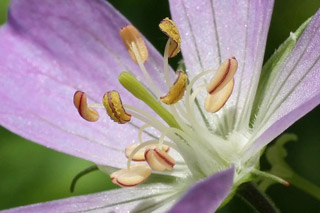 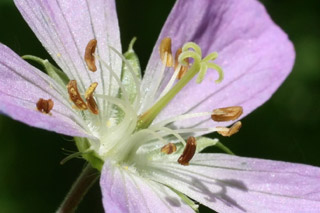
Wild geranum flower details. Left: male phase (note fresh stamens and tightly closed stigma).
Right: female phase (note mostly spent stamens, and spread-out, receptive stigma).
Delaware Wildlife Area
The
Delaware Wildlife Area along Alum Creek at the Marion County-Delaware
County border is an excellent place to see spring wildflowers. In
mid-April I was there with some friends on a wildflower walk, and saw,
on a dry mossy bluff overlooking Alum Creek, this sedge in flower.
Evident in the picture are three groups of flowers on each stem, of
which the uppermost is staminate (male), bearing elongate
pollen-poroducing stamens that are thicker than the pollen-receptive
stigmas that are extending out from beneath the scales of the lower
pistillate (female) flowers.
Carex pensylvanica flowering one month ago, Delaware Wildlife Area, Delaware (or possibly Marion) County, OH.
Here's
the same plant now, with fully mature fruits. The empty scales of
the staminate flowers remain even though the stamens are long gone.
.
Carex pensylvanica in fruit, May 19, 2006, Delaware Wildlife Area.
The common lousewort (Pedicularis canadensis, family Scrophulariaceae) is flowering at this location. It has dissected, almost fern-like foliage.
Common lousewort at Delaware Wildlife Area, May 19, 2008.
OSU at Marion Campus
May 19, 2008
The Larry R. Yoder Prairie at the
OSU-Marion campus is a diverse 10-acre reconsructed prairie.
Three unusual plants recently appeared there. It is interesting to note
the prairie was burned about a month ago. Prairie plants are adapted to
fire, so perhaps the appearance of these plants is a consequence
of the burn. Here's what the burn last month looked like.
Controlled burn at Larry R. Yoder Prairie, April 15, 2008
The exciting plants are low-growing herbs. One of these, bastard-toadflax (Comandra umbellata)
is especially abundant, consisting of several hundred plants over an
area about 30 m. across. Bastard-toadflax is a "hemiparasite," meaning
that it derives some of its nutrition from other plants in the
vicinity, that it connects to through its roots. It looks fairly
normal: green and photosynthetic. You'd never guess it has an unusual
life style. The little yellow flower at its base is yellow-star grass, Hypoxis hirsuta, which is not a grass at all but instead a member of the Amaryllis family, Amaryllidaceae.
Bastard-toadflax (Commandra umbellata) and yellow-star grass (Hypoxis hirsuta)
at Larry R. Yoder Prairie, May 19, 2008.
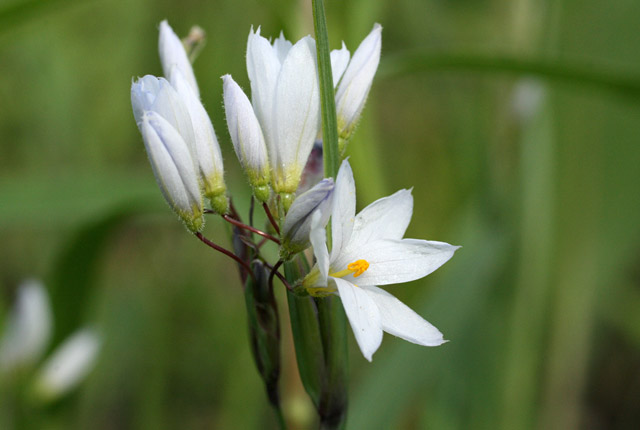
White blue-eyed grass (Sisyrinchium albidum, family Iridaceae) at Larry R. Yoder Prairie, May 19, 2008.
Another plant that is abundant now is starry false Solomon's seal (Smilacina stellata). It resembles the more common woodland species S. racemosa but has larger flowers that are in a simple elongate raceme instead of branched panicle.
Starry false Solomon's seal at Larry R. Yoder Prairie, OSU-Marion.
Meanwhile, cultivated Scotch pine, Pinus sylvestris near
the Student Center is flowering...or whatever it is that non-flowering
seed plants do. Gametophyting? Anyhow, the pines have golden yellow
grape-like clusters of staminate strobili (pollen cones) that look like
they will send off clouds of pollen in the next day or so. Also present
are one-year old cones. Pines have a 2 year reproductive cycle.
In the spring of the first year they produce ovulate cones that receive
pollen. By the end of the first summer, and overwintering, the cones
have developed into tightly closed green cones, about half their final
size.
Scotch pine pollen-producing cones and year-old seed cones, OSU-Marion campus, May 19, 2008.
Meanwhile, the new seed cones are tiny
reddish spiral structures with small scales., and the old (2 year old
ones that scattered their seeds lasy autumn) have fallen off the tree
and now rest on the ground beneath.
Pinus sylvestis. Left: brand-new baby first-year seed
cone.
Right: 2-year old seed cones on ground beneath tree.
More recent observations ("next")
Older observations ("back")
|

